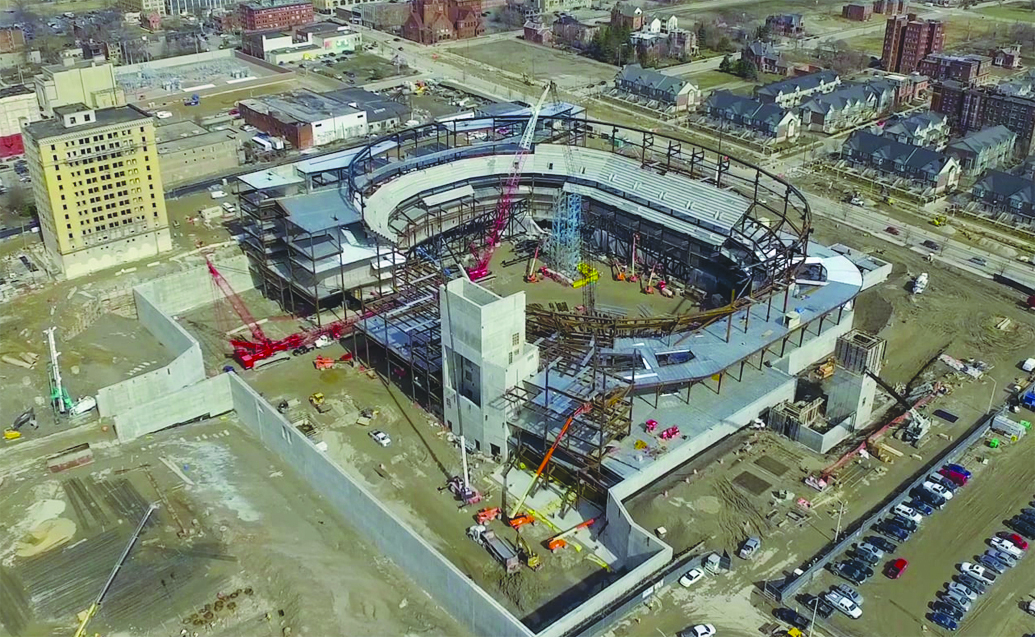Hockey arena takes shape with steel, pre-cast installation
Date Posted: March 25 2016

DETROIT - The new Detroit Red Wings stadium is beginning to look like... an events center.
After having made a deep, wide hole in the ground last summer and fall at the stadium site north of I-75 and west of Woodward, the building trades have made tremendous progress working through the mild winter, building an iron structure that looks like it's almost ready to host a hockey game.
It's not ready, of course, but it's on track to be opened in time for the season opener in October 2017.
"We're right on schedule, right where we want to be," said Sean Hollister, senior project manager for the project management team of Barton Malow/ Hunt/ White. "We started the concrete on time, we started the drilling process on time, we started the structural steel on time. We're going to keep monitoring those measureables to make sure we have a successful finish."
As of the end of January, Olympia Development of Michigan said $308 million in construction contracts had been let on The District Detroit project, including the 20,000-seat hockey arena, which is currently dubbed the Detroit Events Center, subject to the sale of the naming rights.
"When (fans) sit in those stands I think at every level it's going to feel like they're right on top of the play. They're going to be looking right down at the players and feel like they can reach out and touch them." said Midwest Steel project manager Duane Hartley.
Midwest Steel and Iron Workers Local 25 members will place about 7,500 pieces of steel to make up the $627 million arena's structure during the course of the project. The same contractor and crew have also started installing 763 precast concrete sections that will form the arena's stands, with some pieces weighing as much as 38,000 lbs. A 37,300 square-foot practice arena will be part of the project.
The District Detroit is much more than the events center. Construction that's under way includes the pouring of foundations for buildings that will house new retail, eateries and office space that will go up around the stadium.
Olympia Development told the Detroit Free Press in January that an estimated $1.2 billion will be spent on the 45-block District Detroit. Committed to the site are Wayne State University's new Mike Illitch School of Business, and the renovation into residential units of the 13-story former Hotel Eddystone, which was built in 1924 and managed to escape the wrecking ball.
In addition to office space for the Detroit Red Wings and Olympia Entertainment, plans also call for the construction 55,000 square-feet of retail space, and a 350- to 400-room new hotel. Renovated space and new construction of additional housing, office and retail is also expected as part of The District.
But it's the Detroit Red Wings who will be the primary magnet for the 45 block area west of Woodward, which had grown desolate in recent years. The hockey team's present home at Joe Louis Arena was built in 1979 and would never win any awards for architectural beauty, fan access, fan amenities, or seating comfort. Although, The Joe does have decent sight lines, a great ice surface, unique bouncy boards behind the goalies and it has been the home ice of four Stanley Cup championship teams. But it's a worn out building.
Sports architect George Heinlie of HOK said fans will find "the new arena design is unlike any other design in the NHL. It's going to be one of the most intimate and intimidating places for NHL teams to come to play." And Tom Wilson, president and CEO of Olympia Entertainment, promised "the finest arena is going to be right here in downtown Detroit."
(The quotes and source for much of the information in this article came from The District Detroit).
 MORE THAN JUST A NEW HOME for the Detroit Red Wings, The District Detroit encompasses a 45-block parcel of land along Woodward Avenue, which is seen at the top of the photo. To the left is the former Hotel Eddystone (1924), which was saved and will be incorporated into the project. Photo credit: District Detroit
MORE THAN JUST A NEW HOME for the Detroit Red Wings, The District Detroit encompasses a 45-block parcel of land along Woodward Avenue, which is seen at the top of the photo. To the left is the former Hotel Eddystone (1924), which was saved and will be incorporated into the project. Photo credit: District Detroit
